Explore the Learning Laboratory
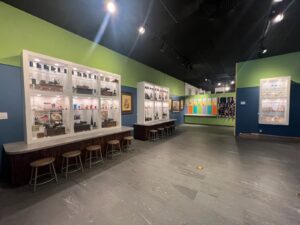
Above: The Learning Laboratory Exhibit
Please note: Information is currently being added to this page. Thank you for your patience.
Welcome to the Learning Laboratory at the Edison and Ford Winter Estates! This space is dedicated to fostering curiosity, historical interest, and a love for learning new things. Whether you’re here to explore our museum, conduct research, or learn more about Thomas Edison and Henry Ford, this exhibit gallery contains a variety of artifacts pertaining to the personal lives and careers of these two famous friends. Our goal is to make your experience both enriching and enjoyable. Click the numbered links below to learn more. Then, click the browser’s back button to return to this page.
• Item 8: Edison Standard Model B Phonograph
• Item 9: Gold-Moulded Cylinder (no title)
• Item 10: Phonograph Horn (witches hat)
• Item 11: Bamboo Filament Bulbs (1, 2, 3)
• Item 12: Edison Home Model A Phonograph
• Item 13: Gold-Moulded Canisters (Flanagan’s Trouble)
Cabinet 3:
• Item 14: Edison Standard Model D Phonograph
• Item 15: Bamboo/Tungsten Lightbulb Combinations (1, 2, 3)
• Item 16: Standard Phonograph
• Item 17: Gold-Moulded Cylinders
Cabinet 4:
• Item 18: Blue Amberol cylinders
• Item 19: Edison Triumph Phonograph
• Item 20: Early Tungsten Bulbs
• Item 21: Edison Concert Phonograph
• Item 22: Concert Cylinders
Cabinet 5:
• Item 23: Black Amberol Cylinder and Canister
• Item 24: Edison Triumph Model B Phonograph
• Item 25: Colored Bulbs (1, 2)
• Item 26: Edison Special Amberol Record
• Item 27: Edison Idelia Model Phonograph
• Item 28: Blue Amberol Cylinders and Canisters (1, 2)
Cabinet 6:
• Item 29: Concert Cylinder Phonograph Model C-159
• Item 30: Various bulbs (1, 2)
• Item 31: Edison Opera Model A Phonograph
• Item 32: Blue Amberol Cylinders
Cabinet 7:
• Item 33: Edicraft Siphonator (coffee maker)
• Item 34: Edison Coffee Pot
• Item 35: Edicraft Toaster
• Item 36: Edison Televoice Phone
• Item 37: Edicraft Iron
• Item 38: GE Whiz Electric Fan
• Item 39: Edicraft Siphonator
• Item 40: Edicraft Iron
• Item 41: Hotpoint Waffle Iron
Cabinet 8:
• Item 42: Konowatt Motor
• Item 43: Edison Shaving Machine Motor
• Item 44: Thomson-Houston Electric Co. Amp Meter
• Item 45: GE Type T-18 Astronomic Time Switch
• Item 46: GE Thomson High Torque Induction Meter
• Item 47: Thomson Voltmeter
• Item 48: Edison Wire Meter
• Item 49: Edison Ampere Meter
• Item 50: Edison Spark Plugs 48T
Cabinet 9:
• Item 51: GE Two Bulb Luminous Heater Type A
• Item 52: GE Three Bulb Luminous Radiator Type A-29
• Item 53: TAE Electric Cap Lamp No. 25
• Item 54: Cap Lamp Battery Cell
• Item 55: TAE Electric Cap Lamp No.29
• Item 56: Edison Kinetoscope
• Item 57: Set of Four Ford Model T Coils
• Item 58: Model A Hubcaps
• Item 59: Model T Items (1, 2, 3, 4, 5)
Cabinet 10:
• Item 60: Edison Radio Filament Battery
• Item 61: Edison Secondary Battery
• Item 62: Edison Secondary Battery (B2)
• Item 63: Edison Dry Battery (BA-203/U)
• Item 64: Edison Oil Bottle
• Item 65: Edison Primary Battery (Jar)
• Item 66: Edison Primary Battery (Jar Lid)
Cabinet 11:
• Item 67: Series of Medallions:
• U.S. Grant Medallion
• Society of Arts & Sciences Medallion
• American Museum of Safety Medallion
• Lewis & Clark Centennial Expo Medallion
• The Hall of Fame of Great Americans Medallion
• Edison Electric Light Co. Medal
• Public Service Medallion
• Illuminating Engineering Society Medal
• P. Turin Medallion
• (Italian) Tessera D. Ricono Scimento Medallion
• Edison 1964 Tokyo Medal
• EFWE Home Medallion
• Edison Primary Battery Medallion
• Edison – Schenectady Medallion
• Edison Centennial of Light
• JP Morgan Medallion
• TAE World Benefactor Medallion
• The Civic Forum Medallion
• Item 68: Glass Ink Well, Shaving Brush Container, Teeth, Desk Clock
• Item 69: Ink Well, Candle – Envelope Sealing Set
• Item 70: Last Supper (Framed Image)
• Item 71: Letter to Thomas Edison
• Item 72: Punch Glasses
• Item 73: Drink Glasses
• Item 74: Salt Cellars
• Item 75: Toiletry Set (1, 2, 3, 4, 5, 6)
• Item 76: Champagne Glasses
• Item 77: Blue Glasses
• Item 78: Drinking Glasses
Cabinet Tops & Shelf Above Screen:
• Item 79: Edison Shaving Machine
• Item 80: Edison Shaving Machine
• Item 81: Edison GEM Phonograph – Model A
• Item 82: Edison Bell Phonograph
• Item 83: Electric Fans (1, 2)
• Item 84: Edison Generator
• Item 85: Edison Rotary Mimeograph and Case
• Item 86: Edison Kinetoscope Home Carrying Case
• Item 87: Sandovar
• Item 88: Go-Go-Hoss Toy Rocking Horse
• Item 89: Miniature High Chair and Table
John Burroughs and the “Vagabonds”
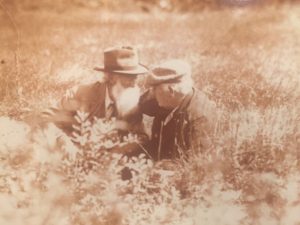
John Burroughs and Thomas Edison
In 1914 popular writer and naturalist John Burroughs arrived with his friend Henry Ford to visit Thomas Edison for the first time at his estate in Fort Myers. Having grown up working on a family farm in New York, Burroughs had long cultivated an interest in nature and enjoyed the outdoors. Burroughs was a member of early expeditions with Ford and Edison into the Everglades, where the group enjoyed discovering nature and some time away from hectic everyday life.
These early Everglades adventures evolved into camping trips across the country, many of which included John Burroughs. The inquisitive Thomas Edison spent many hours enjoying nature with Burroughs, tapping into the naturalist’s vast knowledge of plants and animals.
Burroughs chronicled the trips in scrapbooks which included journals and photos of the self-described “vagabonds.” Visit our “Into the Wild” exhibit in the Edison Ford museum to learn more.
Gardening for Butterflies
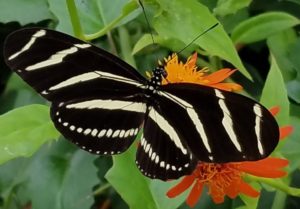
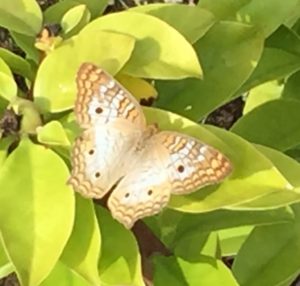 Perhaps you’ve seen some butterflies in your garden and wondered how you could attract more of them. Debbie Hughes, senior horticulturist at Edison and Ford Winter Estates, will talk about butterflies that can be found here in Southwest Florida and which plants you need to attract them to your garden, at the next Garden Talk.
Perhaps you’ve seen some butterflies in your garden and wondered how you could attract more of them. Debbie Hughes, senior horticulturist at Edison and Ford Winter Estates, will talk about butterflies that can be found here in Southwest Florida and which plants you need to attract them to your garden, at the next Garden Talk.
It’s important to know which butterflies already exist in and around your neighborhood. If you live in Southwest Florida, you are not going to be able to attract a butterfly that only resides in California. Once you learn which butterflies are in your area, you can concentrate on the plants that each one needs for survival.
There are two categories of plants that every butterfly garden must have: host plants and nectar plants. Host plants are the ones that butterflies lay eggs on and the caterpillars (larval stage) eat. Nectar plants are simply plants that butterflies will visit for nectar. Both types of plants are essential for butterflies to exist.
Butterflies have very specific requirements for the host plant; some will only lay their eggs on one type of plant. Keep in mind that these plants will get eaten – sometimes every leaf on the plant will be devoured by very hungry caterpillars. Don’t worry, the plants can handle it and new leaves will form in a short amount of time.
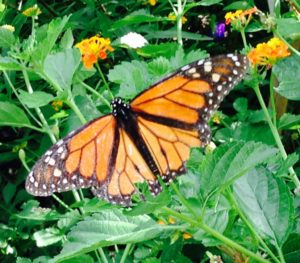 Nectar requirements are not as specific. Some butterflies have favorite nectar sources, but generally, they will visit many different flowers for the sweet, energy-packed, sugary liquid. Some butterflies have color preferences, some like flying low across the yard and others like to fly high amongst tree tops. To attract a wide range of butterflies, it’s a good idea to offer a variety of flower colors and plants that grow at different heights, including ground covers, shrubs and trees.
Nectar requirements are not as specific. Some butterflies have favorite nectar sources, but generally, they will visit many different flowers for the sweet, energy-packed, sugary liquid. Some butterflies have color preferences, some like flying low across the yard and others like to fly high amongst tree tops. To attract a wide range of butterflies, it’s a good idea to offer a variety of flower colors and plants that grow at different heights, including ground covers, shrubs and trees.
To learn about the butterflies of Southwest Florida and how to create a butterfly garden that they won’t be able to resist, come to the Garden Talk on June 9 at 10 a.m. at Edison and Ford Winter Estates. The cost of the workshop is $15 ($10 for Edison Ford members) and all participants will receive a 20% discount coupon for use toward Garden Shoppe purchases. Many different types of host and nectar plants will be available.